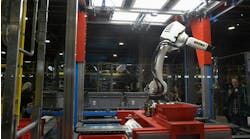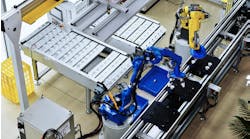Real use cases: Unlocking measurable efficiencies by harnessing AI
What you’ll learn:
- AI is rapidly becoming as fundamental to running a business as the personal computer.
- To keep pace with the dynamic AI landscape, Clarios consults companies outside of the manufacturing sector.
- A key to success is widening the pool of employees who understand their key role in contributing to the AI knowledge base.
For many companies, the wide array of possible AI use cases can be overwhelming. The key is to determine where to apply the technology to realize actual gains.
Many manufacturers already possess the data they need to utilize AI in their operations. For example, historical operational data can be run through a time series analysis to quickly identify opportunities for step changes in continuous improvement. We are even finding new efficiencies in what until now would have been considered fully mature processes.
See also: If AI isn’t the problem, what is? Maybe trust from frontline teams
AI is rapidly becoming as fundamental to running a business as the personal computer. When PCs were introduced, typically only senior leaders had access to the new technology instead of every hire on Day One.
The ideal type of deployment combines leadership’s priorities and employee-identified areas of need, ensuring we focus on enterprise-wide return on investment rather than one-off experiments.
Core to our approach is investing time into upskilling our Top 100 leaders, data scientists, and analytics specialists. Twice a quarter, we engage this broader group by bringing in speakers from the outside to share what they are doing with AI and ramp-up our education on AI patterns.
What is your company doing about cybersecurity?
Quarterly, our AI practice brings forward an executive update to discuss progress and priorities. Leading by example shows our commitment to change management and upskilling to motivate and engage floor workers to utilize AI for problem-solving.
To keep pace with the dynamic AI landscape, we also compare notes with companies outside of the manufacturing sector. We have found that AI has no bounds, leading us to pull ideas from various industries and functions.
Employee engagement from the floor up
A key to success is widening the pool of employees who understand their key role in contributing to the AI knowledge base. We offer learning and development tracks on AI tools and patterns and offer “AI Academy 201” to develop deep expertise in building systems, language models, and machine learning.
See also: AI brought closer to sources of data generation
A crucial selling point and objective for realizing efficiency gains through digital transformation is how it improves the human experience—especially for factory floor workers. AI is an investment in employees to improve workflows and products. In fact, a major benefit from AI is consistency and quality of outcomes.
For example, workers can identify the root cause of a defect or potential defect and then use AI to run scenarios to inform how to accelerate corrective and preventive actions. The value is cutting downtime, improving forecasting and ensuring quality.
Another benefit is freeing up workers to focus on higher-skilled work around the plant. AI also helps workers troubleshoot in real time, improving the experience of working in a challenging environment.
Podcast: AI's role in Kaizen, Lean, technology and continuous improvement
We created an in-house Manufacturing GPT chatbot that enables workers in one location to see, nearly instantaneously, how workers on the other side of the globe fixed a similar issue instead of spending time sifting through static, printed documents. We essentially have leveled the playing field across regions, providing access to the best available knowledge.
Defining priorities with a deployment framework
Defining a deployment framework is key to success. At the front end of AI project management, we create a discovery process of pass/fail based on a hypothesis using a rigorous approach. This kind of robust screening saves time and money. We have chosen these six priority target areas or patterns to guide where else we can leverage efficiencies:
- Forecasting and planning: Demand, supply price and financial forecasting
- Predictive systems: Equipment failure and product defect prediction
- Knowledge management: Automated design repository; policy and procedure helper; IP tracking
- Simulation and digital twins: Virtual battery life monitoring; battery testing simulation; raw material testing simulation
- Computer vision: Quality inspection; workplace safety monitoring; material inspection
- Intelligent automation: Automated RFQ documentation; automated order management; process improvement
Early tactical wins
This is an ongoing journey, and each win informs further actions. We’ve learned that AI affords the opportunity for fast fails and effective course corrections. We’ve adopted a framework to decide which projects to tackle, which starts with whether a deployment will result in demonstrable efficiencies and cost savings.
See also: Lessons for CIOs on how AI is changing the customization game
We now have close to 100 use cases in a backlog of requested solutions. Use cases in development include final inspections in battery-casing production for labels and external cosmetics, and deployment on plate pasting lines to catch defects as early-on as possible. Our milestone achievements to date include:
Machine-learning sleuthing: A team of engineers and IT analytics professionals used cloud-based machine learning and six months of time-series data to identify a missing control variable for a 30-plus-year-old process. The breakthrough is already saving $3 million per year in one plant and resulted in a patent filing on the new control scheme.
Trouble-shooting chatbot: To solve the problem of too few experts to problem-solve the installation of new lines at multiple Clarios facilities globally, our experts built the conversational Manufacturing GPT bot, which is being used about 250 times per month by line operators, supervisors and maintenance mechanics, leading to quicker installations and improved overall equipment effectiveness.
AI for vision inspection: To unlock greater speed and efficiency in quality control and inspection, we are leveraging AI to identify potential non-conformities inside batteries in the assembly department after the cast on strap has been applied.
The solution has been deployed in a Clarios plant in the Europe, Middle East, and Africa region. Although it failed at first, we continued to iterate on it and develop further until it worked. Vision inspection is leading to prescriptive solutions, with AI identifying a root cause of a defect from several processes upstream of the resulting issue.
See also: Reliability teams need AI-ready digital blueprints now more than ever
Separately, we are preparing to install a vision system coupled to a robot in the formation department. This robot will depalletize batteries to a conveyor belt using AI and vision technology to detect the position and orientation of the batteries on the pallet. With this knowledge, the robot can reposition itself to improve the picking accuracy compared to traditional camera methods.
We have found this intentional approach to AI implementation creates a virtuous cycle, with one good outcome leading to another—compounding efficiency gains and opening up new use-case opportunities.
We recognize that we have barely scratched the surface of the potential for AI. The only constant in AI is change. It can be overwhelming, but it is truly exciting and very rewarding.




